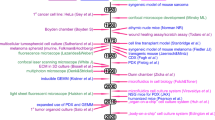Transwell In Vitro Cell Migration and Invasion Assays

Cell migration and invasion have essential roles in both normal physiology and disease. As such, methodologies to assess cell migratory and invasive capacities are necessary to elucidate normal cell processes and underlying mechanisms of disease. Here, we describe commonly used transwell in vitro methods for the study of cell migration and invasion. The transwell migration assay involves the chemotaxis of cells through a porous membrane after the establishment of a chemoattractant gradient using two medium-filled compartments. The transwell invasion assay involves the addition of an extracellular matrix on top of the porous membrane which only permits chemotaxis of cells which possess invasive properties such as tumor cells.
This is a preview of subscription content, log in via an institution to check access.
Access this chapter
Subscribe and save
Springer+ Basic
€32.70 /Month
- Get 10 units per month
- Download Article/Chapter or eBook
- 1 Unit = 1 Article or 1 Chapter
- Cancel anytime
Buy Now
Price includes VAT (France)
eBook EUR 181.89 Price includes VAT (France)
Softcover Book EUR 163.51 Price includes VAT (France)
Hardcover Book EUR 232.09 Price includes VAT (France)
Tax calculation will be finalised at checkout
Purchases are for personal use only
Similar content being viewed by others

Current methods for studying metastatic potential of tumor cells
Article Open access 09 December 2022

Two-Dimensional vs. Three-Dimensional In Vitro Tumor Migration and Invasion Assays
Chapter © 2013

Determination of Breast Cancer Cell Migratory Ability
Chapter © 2016
References
- Eksteen B, Liaskou E, Adams DH (2008) Lymphocyte homing and its role in the pathogenesis of IBD. Inflamm Bowel Dis 14(9):1298–1312. https://doi.org/10.1002/ibd.20453ArticlePubMedGoogle Scholar
- Bauer A, Tatliadim H, Halin C (2022) Leukocyte trafficking in lymphatic vessels. Cold Spring Harb Perspect Med 12. https://doi.org/10.1101/cshperspect.a041186
- Liesveld JL, Sharma N, Aljitawi OS (2020) Stem cell homing: from physiology to therapeutics. Stem Cells 38(10):1241–1253. https://doi.org/10.1002/stem.3242ArticlePubMedGoogle Scholar
- Maddaluno L, Urwyler C, Werner S (2017) Fibroblast growth factors: key players in regeneration and tissue repair. Development 144(22):4047–4060. https://doi.org/10.1242/dev.152587ArticleCASPubMedGoogle Scholar
- Hall A (2009) The cytoskeleton and cancer. Cancer Metastasis Rev 28(1–2):5–14. https://doi.org/10.1007/s10555-008-9166-3
- Nagano M, Hoshino D, Koshikawa N, Akizawa T, Seiki M (2012) Turnover of focal adhesions and cancer cell migration. Int J Cell Biol 2012:310616. https://doi.org/10.1155/2012/310616ArticleCASPubMedPubMed CentralGoogle Scholar
- Yilmaz M, Christofori G (2010) Mechanisms of motility in metastasizing cells. Mol Cancer Res 8(5):629–642. https://doi.org/10.1158/1541-7786.MCR-10-0139ArticleCASPubMedGoogle Scholar
- Sanderlin EJ, Leffler NR, Lertpiriyapong K, Cai Q, Hong H, Bakthavatchalu V, Fox JG, Oswald JZ, Justus CR, Krewson EA, O’Rourke D, Yang LV (2017) GPR4 deficiency alleviates intestinal inflammation in a mouse model of acute experimental colitis. Biochim Biophys Acta 1863(2):569–584. https://doi.org/10.1016/j.bbadis.2016.12.005ArticleCASGoogle Scholar
- Krewson EA, Sanderlin EJ, Marie MA, Akhtar SN, Velcicky J, Loetscher P, Yang LV (2020) The proton-sensing GPR4 receptor regulates paracellular gap formation and permeability of vascular endothelial cells. iScience 23(2):100848. https://doi.org/10.1016/j.isci.2020.100848ArticleCASPubMedPubMed CentralGoogle Scholar
- Marie MA, Sanderlin EJ, Satturwar S, Hong H, Lertpiriyapong K, Donthi D, Yang LV (1868) GPR65 (TDAG8) inhibits intestinal inflammation and colitis-associated colorectal cancer development in experimental mouse models. Biochim Biophys Acta Mol basis Dis 2022(1):166288. https://doi.org/10.1016/j.bbadis.2021.166288ArticleCASGoogle Scholar
- Amantea D, Nappi G, Bernardi G, Bagetta G, Corasaniti MT (2009) Post-ischemic brain damage: pathophysiology and role of inflammatory mediators. FEBS J 276(1):13–26. https://doi.org/10.1111/j.1742-4658.2008.06766.xArticleCASPubMedGoogle Scholar
- Itatani Y, Kawada K, Inamoto S, Yamamoto T, Ogawa R, Taketo MM, Sakai Y (2016) The role of chemokines in promoting colorectal cancer invasion/metastasis. Int J Mol Sci 17(5). https://doi.org/10.3390/ijms17050643
- Castellone RD, Leffler NR, Dong L, Yang LV (2011) Inhibition of tumor cell migration and metastasis by the proton-sensing GPR4 receptor. Cancer Lett 312(2):197–208. https://doi.org/10.1016/j.canlet.2011.08.013ArticleCASPubMedGoogle Scholar
- Justus CR, Leffler N, Ruiz-Echevarria M, Yang LV (2014) In vitro cell migration and invasion assays. J Vis Exp 88:e51046. https://doi.org/10.3791/51046ArticleCASGoogle Scholar
- Radu CG, Yang LV, Riedinger M, Au M, Witte ON (2004) T cell chemotaxis to lysophosphatidylcholine through the G2A receptor. Proc Natl Acad Sci U S A 101(1):245–250. https://doi.org/10.1073/pnas.2536801100ArticleCASPubMedGoogle Scholar
- Rodriguez LG, Wu X, Guan JL (2005) Wound-healing assay. Methods Mol Biol 294:23–29. https://doi.org/10.1385/1-59259-860-9:023ArticlePubMedGoogle Scholar
- Justus CR, Sanderlin EJ, Dong L, Sun T, Chi JT, Lertpiriyapong K, Yang LV (2017) Contextual tumor suppressor function of T cell death-associated gene 8 (TDAG8) in hematological malignancies. J Transl Med 15(1):204. https://doi.org/10.1186/s12967-017-1305-6ArticleCASPubMedPubMed CentralGoogle Scholar
- Yang LV, Radu CG, Wang L, Riedinger M, Witte ON (2005) Gi-independent macrophage chemotaxis to lysophosphatidylcholine via the immunoregulatory GPCR G2A. Blood 105(3):1127–1134. https://doi.org/10.1182/blood-2004-05-1916
- Junger WG (2008) Purinergic regulation of neutrophil chemotaxis. Cell Mol Life Sci 65(16):2528–2540. https://doi.org/10.1007/s00018-008-8095-1ArticleCASPubMedPubMed CentralGoogle Scholar
- Peter C, Waibel M, Radu CG, Yang LV, Witte ON, Schulze-Osthoff K, Wesselborg S, Lauber K (2008) Migration to apoptotic “find-me” signals is mediated via the phagocyte receptor G2A. J Biol Chem 283(9):5296–5305. https://doi.org/10.1074/jbc.M706586200ArticleCASPubMedGoogle Scholar
- Roussos ET, Condeelis JS, Patsialou A (2011) Chemotaxis in cancer. Nat Rev Cancer 11(8):573–587. https://doi.org/10.1038/nrc3078ArticleCASPubMedPubMed CentralGoogle Scholar
- Zhang X, Goncalves R, Mosser DM (2008) The isolation and characterization of murine macrophages. Curr Protoc Immunol Chapter 14:Unit 14 11 https://doi.org/10.1002/0471142735.im1401s83
- Ying W, Cheruku PS, Bazer FW, Safe SH, Zhou B (2013) Investigation of macrophage polarization using bone marrow derived macrophages. J Vis Exp 76:e50323. https://doi.org/10.3791/50323ArticleCASGoogle Scholar
Acknowledgments
The work was supported by research grants from the National Institutes of Health (R03CA249473 and R15DK109484, to L.V.Y.). C.R.J., M.A.M., and E.J.S. contributed equally to this work.
Author information
Authors and Affiliations
- Department of Internal Medicine, Brody School of Medicine, East Carolina University, Greenville, NC, USA Calvin R. Justus, Mona A. Marie, Edward J. Sanderlin & Li V. Yang
- Calvin R. Justus


